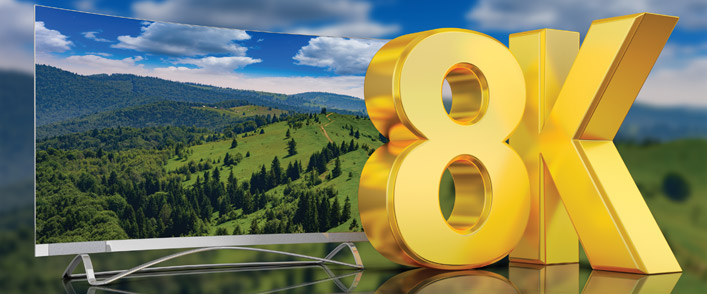
By John R. Quain
Editor at Large, Tech 50+
(www.tech50plus.com)
First it was HD TV, then 4K Ultra HD TV, then HDR. Now it’s 8K, with the first sets poised to appear in Europe. The question is, do you really need more pixels?
The big reveal
At the IFA Consumer Electronics Global Press Conference in Rome in April, Sharp introduced the first 8K television to be sold in the EU. The 70-inch LCD sets was due to debut at the end of the month at a “if you have to ask, you can’t afford it” price of around $12,000. The TVs are referred to as 8K sets because have nearly 8,000 horizontal lines of resolution (7,680 by 4,320 pixels).
The wow factor
In demonstrations at the IFA event, the Sharp 8K set certainly revealed impressive picture details. People jostling as they debarked a commuter train looked as if they were walking into your living room, with faces showing every line and wrinkle. Yet there were some minor picture artifacts in other scenes, demonstrating the difficulty of transmitting such high-resolution data.
Streaming 4K video today, for example, requires an Internet connection of from 15 Mbps to 25 Mbps. To send 8K video streaming online would require at least double those speeds from your Internet provider.
Furthermore, while YouTube has a few 8K videos, few mainstream broadcasters have committed to the format. The one exception is NHK in Japan, which plans to create a full-blown 8K broadcast channel soon.
The future is now
Paul Gray, a lead researcher and analyst at IHS Markit, said that even though there’s a paucity of 8K programming, TV makers are keen on the format in order to gain an advantage in the “hypercompetitive” TV market.
“Within 18 months, everybody will be showing flagship 8K sets,” said Gray.
With four times the number of pixels – 33,177,600 versus 8,294,400 – the new 8K sets can display a realism that’s unmatched in current 4K Ultra HD TVs. Sharp’s vice president for marketing and sales, Sascha Lange, also noted that the 8K sets can upscale existing 4K material to 8K.
But do we want it?
There’s been some skepticism, however, about consumers moving up to bigger TV sizes (70-inches and above), where 8K resolutions will really shine. But market analysts at Gfu – research arm of IFA – noted in a separate presentation at the IFA event that living rooms around the world are changing. No longer are family rooms cluttered with multiple bookshelves (who needs paper books when you have ebooks?) or bulky stereo systems (who needs a big receiver or records when you’ve got Spotify?). That leaves plenty of wall space for a bigger TV.
The bottom line
If you’re thinking of moving up to 8K, you should realize that the official specification won’t be finalized until later this year (if then). And refresh rates, which tend to make a bigger impression on viewers than simply more pixels, haven’t even been established. Furthermore, Sharp is in a legal tangle with Chinese TV maker Hisense, which currently has the rights to distribute sets under the Sharp brand in the U.S. So don’t expect to see a Sharp 8K TV for sale here any time soon.
Still, the endless drive to create the perfect picture means that 8K TVs look to be an inevitable part of our television future. The good news? Prices will come down.
“It’s being driven by the Chinese panel makers,” said Gray, “and there’s going to be a race to the bottom.”
John R. Quain writes for The New York Times, U.S. News and World Report, Fox News, Tom’s Guide and several other publications. He is also the personal technology columnist for Foxnews.com and has been an on-air reporter for CBS News Up to the Minute. His articles have appeared in Esquire, Rolling Stone, and Entertainment Weekly. Quain is a member of the International Consumer Electronics Show advisory board and an advisor to Driving Summit.